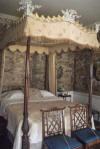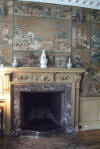
 Front and side elevations of house; front elevation of Orangery.
Front and side elevations of house; front elevation of Orangery.Holiday in Devon, Friday 28th March - Friday 4th April 2014
Drum Cottage, Liverton, Near Newton Abbot, Devon.
Home Devon Day 1 Day 2 Day 3 Day 4 Day 5 Day 7 Day 8
Day 6 - Wednesday 2nd April 2014
It rained overnight and it continued to rain on and off for most of the day. and the visibility on the A38 south was severely reduced by spray. Saltram House was difficult to find as signage was poor, we could not access the website for directions as broadband is hard to find in rural Devon, and directions are no longer printed in the handbook. However, we persevered and eventually came across a sign which led us on.
Saltram house, once found, is a gem with many original furniture, fittings and paintings still in the house. The original Tudor building can still be identified and the whole house blends to give a very enjoyable experience. The kitchen still has much of the victorian fittings with some ingenious solutions, such as the free standing solid fuel range in the centre of the kitchen, but the flue gases end up in the great chimney. The free standing range was supplied by a firm in Leamington.

![]()
 Front and side elevations of house; front elevation of Orangery.
Front and side elevations of house; front elevation of Orangery.
The garden is attractive with a Castle Folly (actually a summerhouse with mock battlements) at one end, an Orangery based on the one at Croome Court, a chapel now used as a tea room - very nicely presented afternoon cream teas.

 Information board about Castle Folly; front elevation of Castle Folly. Inside
plain whitewashed walls; Underground vault/cellar from earlier structure;
both
not photographed.
Information board about Castle Folly; front elevation of Castle Folly. Inside
plain whitewashed walls; Underground vault/cellar from earlier structure;
both
not photographed.


 Interior photographs of Drawing Room, Saloon; Dining Room.
Interior photographs of Drawing Room, Saloon; Dining Room.



 Interior photographs of kitchen (note iron island range far left), view of end
of kitchen, Scullery, Still Room.
Interior photographs of kitchen (note iron island range far left), view of end
of kitchen, Scullery, Still Room.




 Interior views of some bedrooms.
Interior views of some bedrooms.




 Library-3 views, Large gilded desk by Charles Boulle about 1700, games
table,
Library-3 views, Large gilded desk by Charles Boulle about 1700, games
table,
Later in the afternoon we drove across to Overbecks, an Edwardian/Victorian house now used as a museum. Otto Overbecks was an industrial chemist who worked for a brewery in Grimsby for many years. During that period he developed many inventions, including a process to extract the alcohol from beer, methods of testing for alcohol content, a yeast based product similar to Marmite but much earlier. Following an illness which was declared non-treatable, he started testing electrical based techniques and developed and patented an electrical stimulation machine. He sold thousands around the world - The Overbecks Rejuvenator - despite the medical profession rubbishing his claims. He died in 1937 and the property was given to the National Trust, but without any cash. The Rejuvenator was taken over by his brother-in-law and another colleague, but sales collapsed during WW2 and the company was wound up in 1940. The house is now really a museum displaying Overbecks many collections.
 Front elevation of Overbecks House. No photography attempted inside
Overbecks as too dark and flash not allowed.
Front elevation of Overbecks House. No photography attempted inside
Overbecks as too dark and flash not allowed.